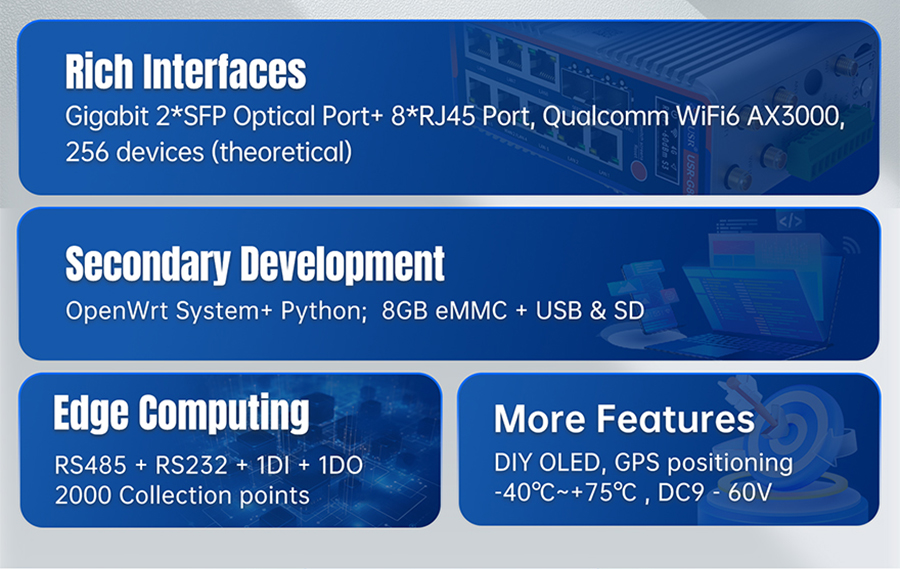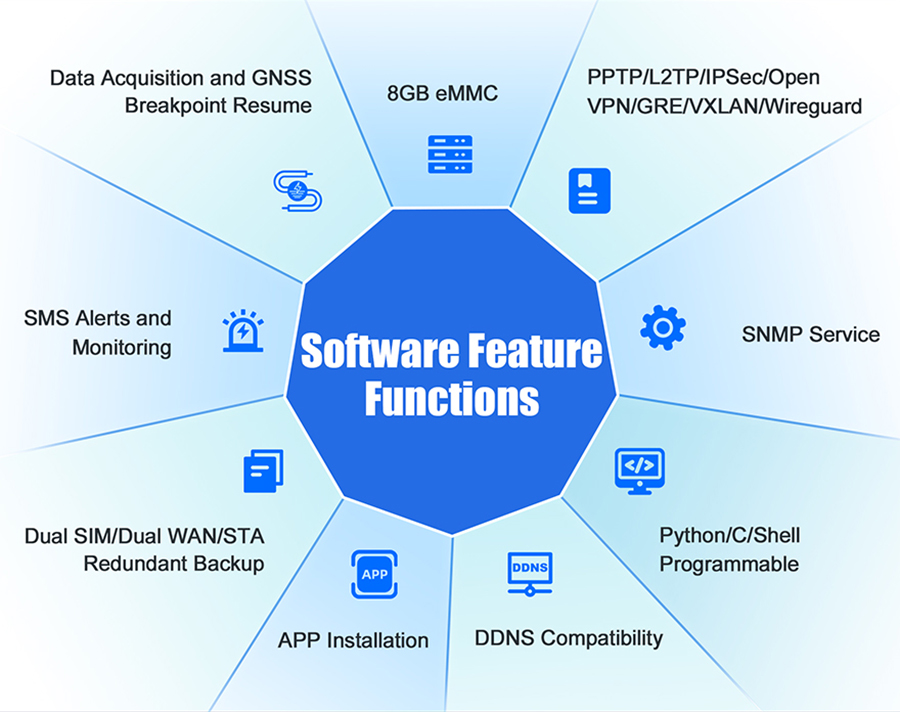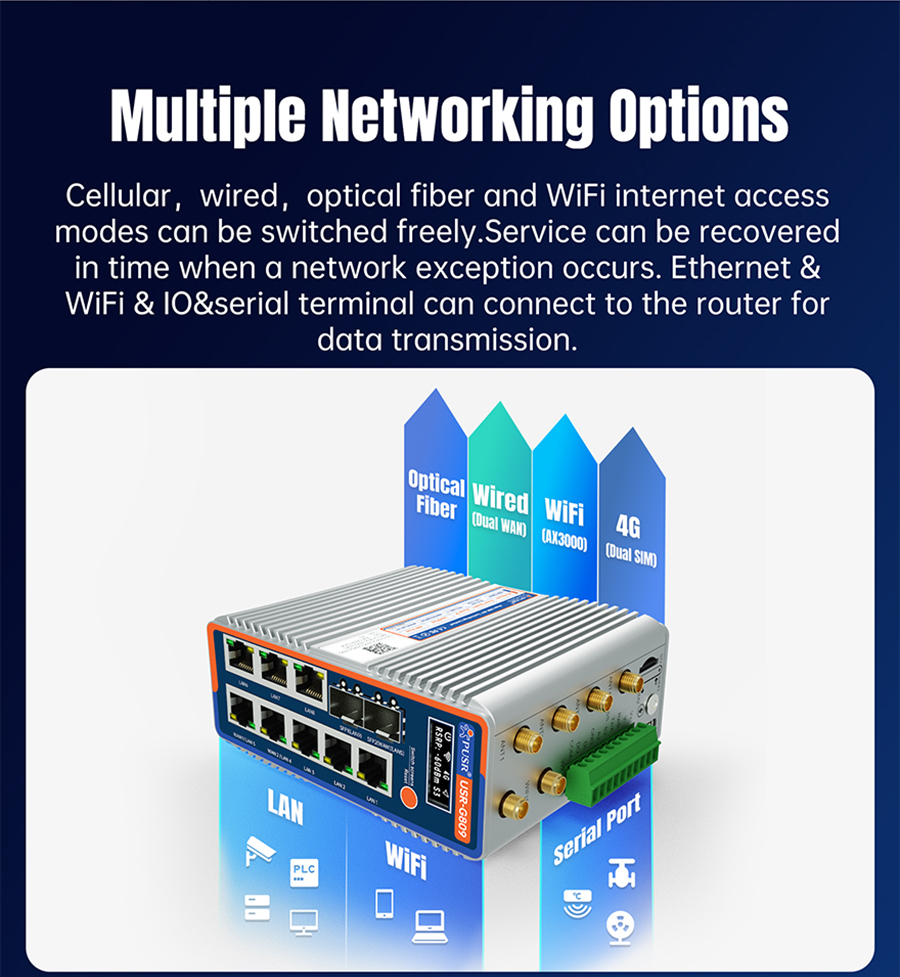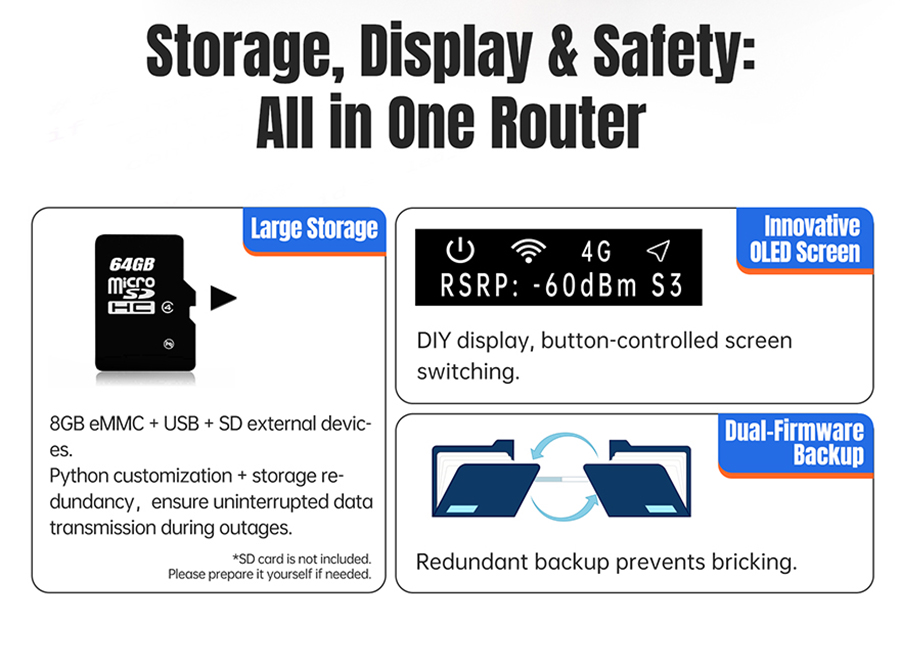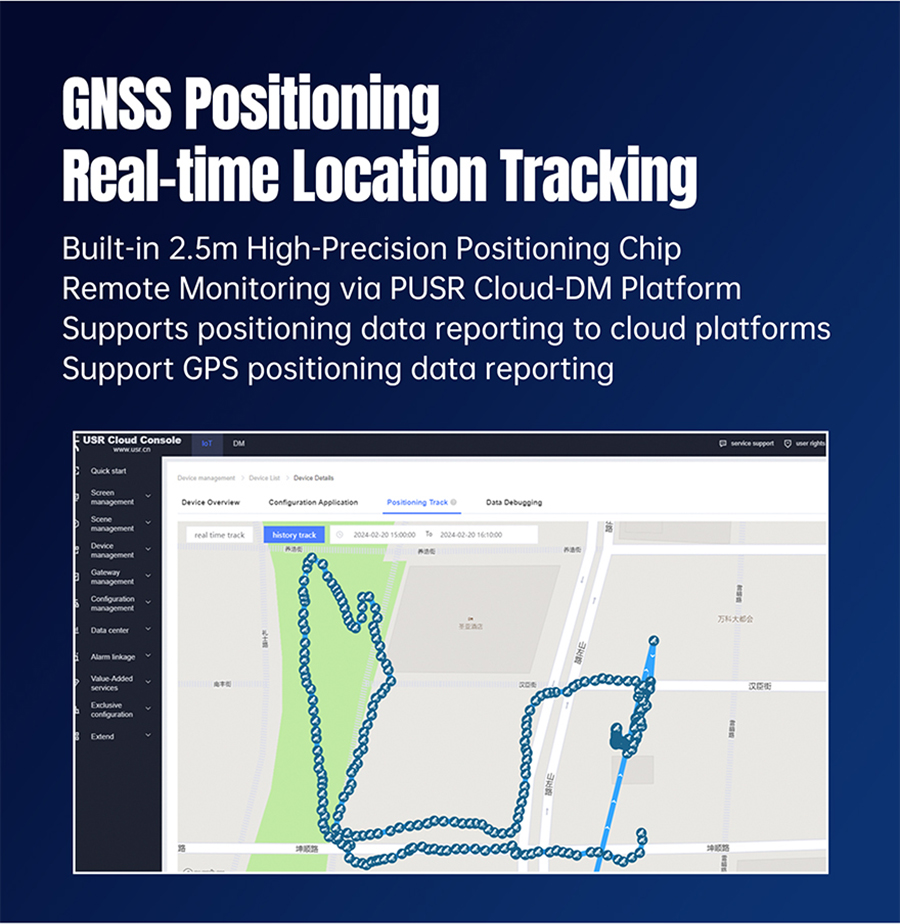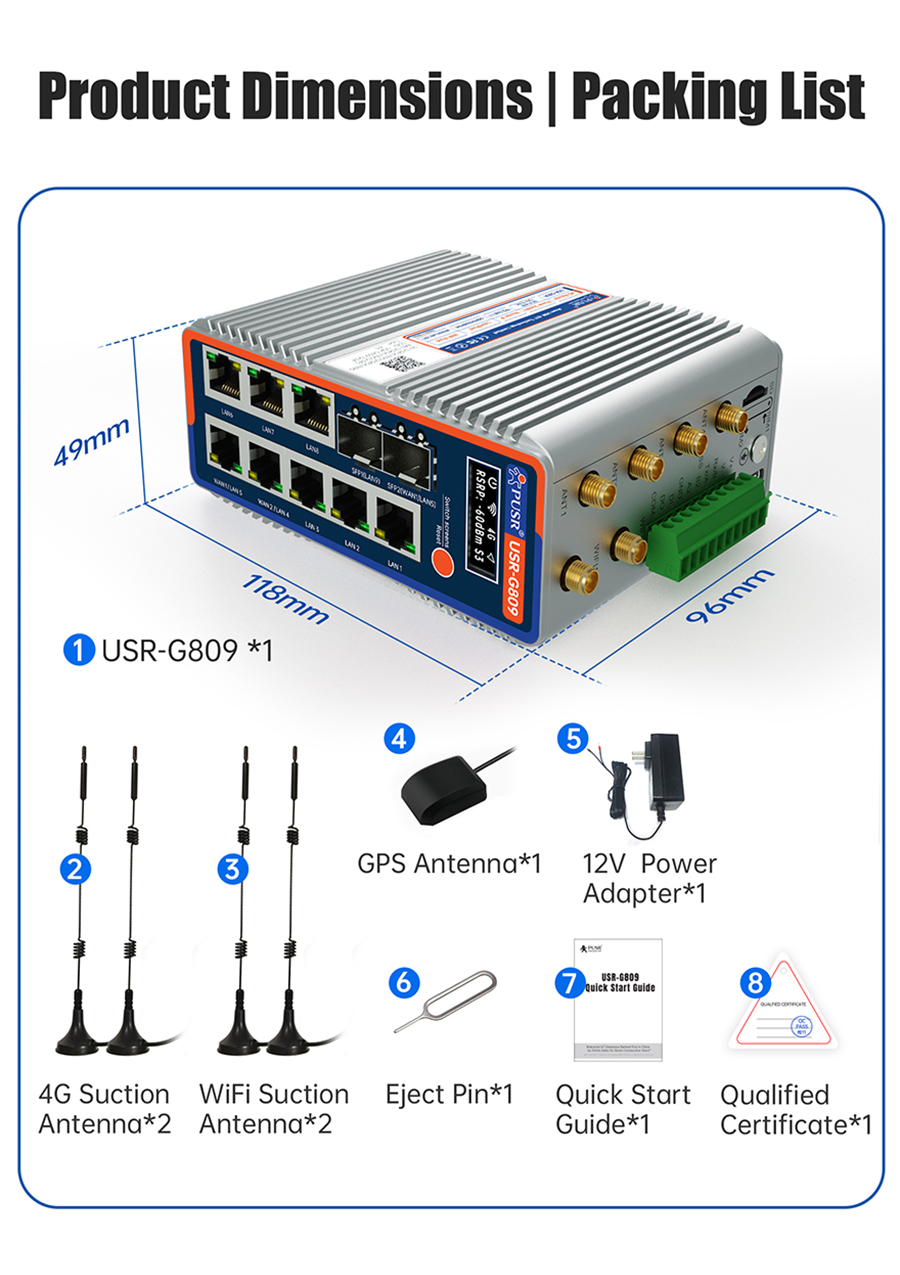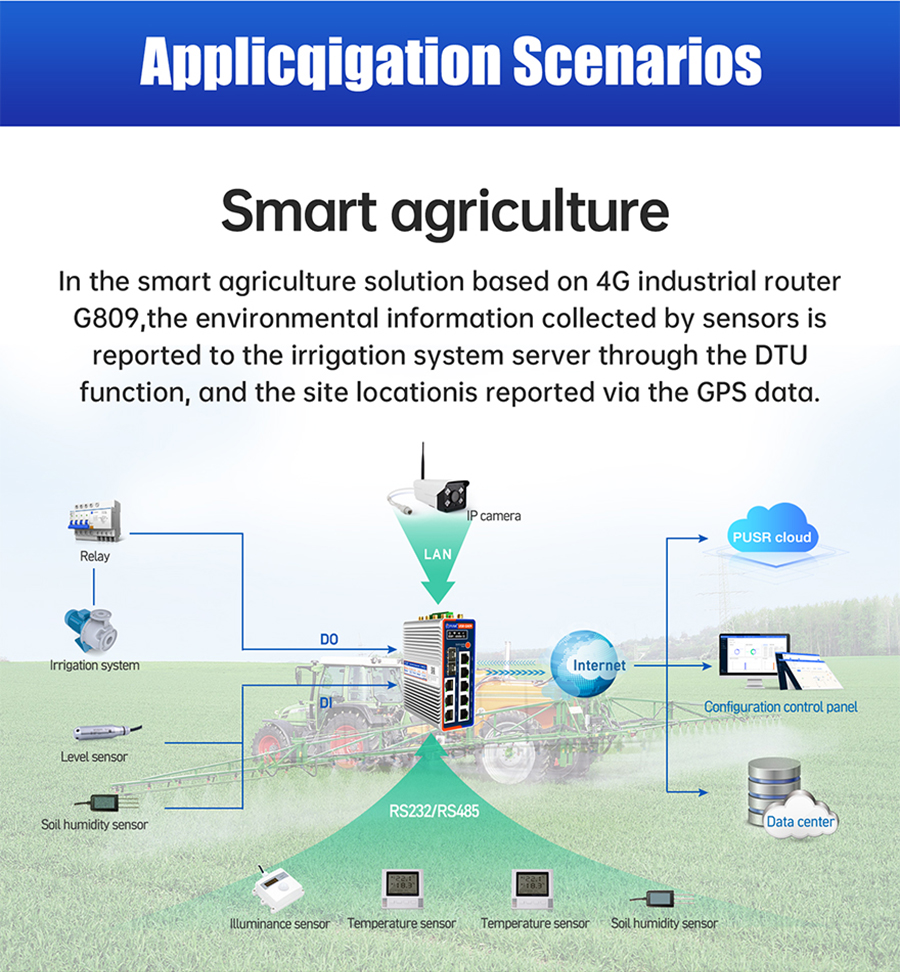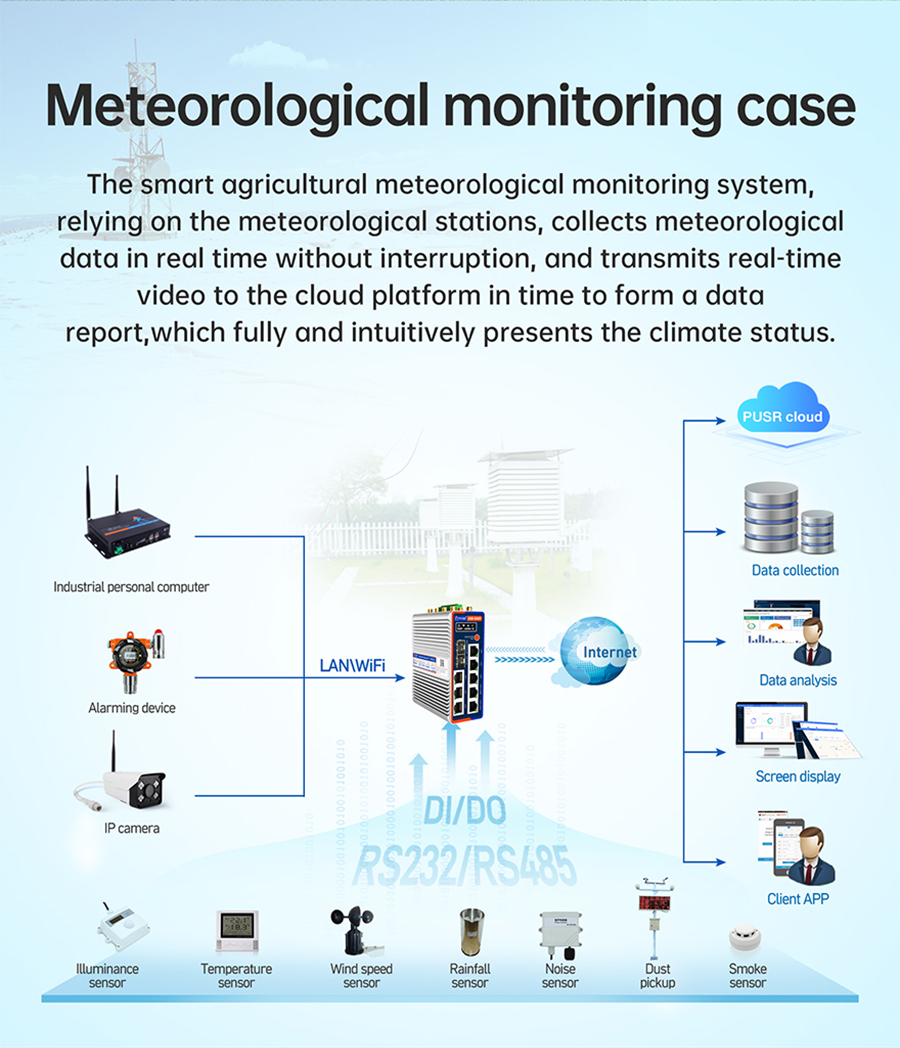Against the backdrop of Industry 4.0 and the Internet of Everything, traditional network devices can no longer meet the demands for low latency, high reliability, and strong security in scenarios such as smart manufacturing and smart cities. PUSR's USR-G809s Gigabit Edge Router, driven by a dual-wheel approach of "industrial-grade hardware + intelligent software," redefines the performance boundaries of industrial network devices. This article will provide an in-depth analysis of the core value of this flagship product from three dimensions: technical architecture, application scenarios, and networking innovation.
1. Conceptual Breakthrough: From Gigabit Routers to Edge Computing Hubs
1.1 What is a Gigabit Router: The Art of Balancing Speed and Stability
The core value of a Gigabit Router lies in its 1000Mbps (1Gbps) physical layer transmission capability, but industrial scenarios demand far more from devices. The USR-G809s achieves stable data forwarding under gigabit bandwidth through a hardware combination of a quad-core ARM Cortex-A7 processor and 512MB DDR3 memory. In real-world testing at an electronics manufacturing plant in Shenzhen, the device maintained a 99.97% packet forwarding rate while simultaneously supporting 200 PLC devices, 4K video surveillance streams, and MES system data, far surpassing the industry average.
1.2 What is an Edge Router: From Data Channels to Intelligent Nodes
The key to an Edge Router lies in its ability to decentralize computing power to the network edge. The USR-G809s, equipped with a built-in Python scripting engine and OpenWrt open-source system, enables localized data processing capabilities. In a smart agriculture project in Shandong, the device performed real-time analysis of soil temperature and humidity sensor data through custom scripts, uploading only anomalous values to the cloud, reducing data transmission volume by 92%. Simultaneously, it directly controlled irrigation systems via DO interfaces, achieving millisecond-level responsiveness.
1.3 What is a Gigabit Edge Router: The Technological Breakthroughs of the USR-G809s
As the world's first edge device integrating 5G/4G/3G/2G multi-mode communication, Gigabit Ethernet, WiFi6, and industrial serial ports, the USR-G809s achieves three industry firsts:
First-ever Triple-Network Intelligent Switching: Supports simultaneous online connectivity for wired, 4G, and 5G links, with automatic switching within 0.3 seconds in case of primary link failure.
Highest Interface Density: 1 WAN port + 4 LAN ports + 1 RS232/RS485 serial port + 2 DI/2 DO control interfaces.
Broadest Operating Temperature Range: Adapts to extreme environments from -40°C to +70°C.
2. Hardware Dissection: The Industrial DNA of the Gigabit Edge Router USR-G809s
2.1 Interface Matrix: The Physical Foundation for 2000-Point Data Acquisition
The interface layout on the rear of the device resembles an industrial interface museum:
RS232/RS485 Serial Ports: Supports Modbus RTU/TCP protocol conversion, enabling direct connection to 2000 sensor nodes.
DI/DO Interfaces: 2 digital inputs (supporting dry/wet contacts) and 2 relay outputs for device status monitoring and emergency braking.
SIM Card Slots: Dual-SIM dual-standby design supporting APN/VPDN private network access.
In an application at a steel plant in Hebei, 1872 temperature sensors were connected via RS485 interfaces, 36 blast furnace blower states were monitored via DI interfaces, and 12 emergency shut-off valves were controlled via DO interfaces, establishing a comprehensive equipment health management system across the plant.
2.2 Protection System: The Survival Rulebook for Industrial Environments
The metal enclosure (IP30 protection rating) houses multiple protection mechanisms:
Power Protection: 9-36V wide voltage input with reverse polarity protection, overvoltage protection, and surge suppression (6kV/3kA).
Electromagnetic Compatibility: Certified to IEC61000-4-2 (ESD), IEC61000-4-4 (EFT), and IEC61000-4-5 (Surge) standards.
Environmental Adaptability: Operates from -40°C to +70°C with 5%-95% RH non-condensing humidity.
In a solar power plant project on the Qinghai Plateau, the device operated continuously and stably for over 18 months in -32°C freezing conditions, validating its extreme environment adaptability.
2.3 Intelligent Early Warning: From Reactive Maintenance to Proactive Prevention
The built-in hardware watchdog and fault self-detection system continuously monitor:
CPU/memory utilization
Interface traffic anomalies
Signal strength fluctuations
When anomalies are detected, it immediately triggers three-level alarms via SMS, email, and DO relay outputs. In an application at a chemical plant in Zhejiang, the system detected a reactor temperature sensor failure 37 minutes in advance, preventing a major safety incident.
3. Networking Revolution: Reconstructing Industrial Connectivity Through Remote Networking
3.1 Hybrid Networking Architecture: Breaking Geographical Boundaries
The USR-G809s supports five networking modes:
Wired Priority: Primary link as fiber, backup link as 4G.
Wireless Private Network: Builds enterprise virtual private networks (VPNs) via 5G/4G.
Star Topology: Central + multiple remote sites.
Chain Topology: Suitable for pipeline monitoring with linear layouts.
Hybrid Topology: Multi-level backup combining wired, wireless, and satellite links.
During the construction of the Sichuan-Tibet Railway, a chain-type network was deployed using a "central机房- tunnel base station - vehicle-mounted device" architecture, ensuring real-time connectivity for construction equipment at 4500 meters above sea level through 5G+4G dual-link backup.
3.2 Value Creation Through Remote Networking
Cost Optimization: An automotive manufacturer reduced IT equipment investment in branch offices by 63% through remote networking.
Efficiency Improvement: Latency for remote workers accessing enterprise resources dropped from 120ms to 28ms.
Business Continuity: During the 2024 Zhengzhou flood disaster, a bank maintained uninterrupted operation of its core systems for 72 hours through remote networking.
4. Software Empowerment: The Ecological Revolution of OpenWrt + Python
4.1 OpenWrt's Open Ecosystem
The Linux-based OpenWrt system offers:
Plugin Marketplace: Supports over 300 industrial protocol drivers (e.g., Profinet, EtherCAT).
Remote Management: Enables centralized global device management via the USR Cloud Platform.
Security Hardening: Built-in firewall, IPSec VPN, and Chinese national cryptographic SM4 encryption algorithm.
An equipment manufacturing enterprise quickly integrated Siemens S7 protocol drivers through the OpenWrt plugin marketplace, reducing device networking cycles from three months to two weeks.
4.2 Python Scripting's Customization Capabilities
The built-in MicroPython environment supports:
Protocol Conversion: Real-time conversion from Modbus TCP to OPC UA.
Edge Computing: Localized data cleaning and anomaly detection preprocessing.
Automated Control: Automatic adjustment of equipment parameters based on sensor data.
At a photovoltaic power plant in Jiangsu, Python scripts optimized inverter efficiency in real-time, boosting power generation by 4.2%.
5. Industry Applications: From Concept to Real-World Value Validation
5.1 Smart Manufacturing: Digital Twins in Automotive Factories
At BYD's Changsha plant, the USR-G809s established an industrial network covering four major workshops—stamping, welding, painting, and final assembly:
Latency Control: Mechanical arm control command transmission latency <5ms.
Protocol Compatibility: Simultaneously supports EtherCAT, Profinet, and Modbus industrial protocols.
Redundancy Design: Dual-link backup ensures 99.999% availability.
After implementation, the Overall Equipment Effectiveness (OEE) increased by 18%, saving ¥3.2 million in annual operation and maintenance costs.
5.2 Smart Cities: The Invisible Guardian of Underground Pipelines
Shenzhen Water Group deployed USR-G809s across the city's drainage network:
LoRa Integration: Connects 2000 liquid level sensors via RS485 interfaces.
AI Analysis: Python scripts perform real-time water flow data analysis to predict pipeline blockage risks.
Emergency Response: DI interfaces monitor manhole cover status, while DO interfaces control drainage pump operation.
After system deployment, pipeline fault response times shortened from 4 hours to 12 minutes, reducing annual flood damage losses by ¥120 million.
5.3 Energy Management: The Intelligent Brain of Photovoltaic Power Plants
State Power Investment Corporation's application at the Qinghai Gonghe Photovoltaic Power Station:
5G + Edge Computing: Uploads image data via 5G while performing component fault identification locally.
Multi-Mode Communication: Uses 4G as a backup link to ensure continuous operation during overcast weather.
Energy Efficiency Optimization: Python scripts dynamically adjust tracking bracket angles based on light intensity.
After implementation, power generation efficiency increased by 6.8%, while operation and maintenance costs decreased by 41%.
6. Future Outlook: The Infinite Possibilities of Edge Intelligence
With the maturation of technologies such as TSN (Time-Sensitive Networking), 6GHz WiFi7, and 5G-Advanced, the next generation of USR-G809s products will achieve:
Sub-millisecond Latency Control: Meets demanding scenarios like motion control.
Built-in AI Computing Power: Integrates NPU chips for localized AI inference.
Digital Twin Support: Constructs digital mirrors of physical devices via OPC UA over TSN.
In the vast expanse of the Industrial Internet, the PUSR router USR-G809s has proven that true edge intelligence is not merely about device connectivity but about constructing a trustworthy, efficient, and flexible digital foundation for industrial digital transformation through hardware innovation, software openness, and ecological co-construction. This product, embodying a decade of industrial networking experience, is redefining the value of "connection"—evolving from a mere data channel into a catalyst for industrial transformation.

